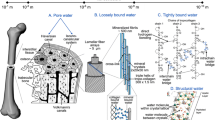Abstract
The binding of water in bone was re-examined by differential centrifugation. Specimens of human trabecular were cleaned in a jet stream of water, degassed in water, and subjected to centrifugation fields, varying from 100 to 27.000 g's in sealed vials in a refrigerated centrifuge. Specimens were run in groups of six. The specimens were subjected to 4 centrifugation fields with rehydration and degassing between treatments. The specimens were dried and the residual water after each treatment was calculated. Specimens were centrifuged in a particular field until no further weight loss occurred with further centrifugations. There was a rapid exponential drop in water content as a function of centrifugation force between 120 and 1000 g's. The exponential nature of the loss and its sudden exhaustion suggest one discrete, extremely loosely bound compartment probably corresponding to the water on the outside surfaces of the specimens. Above 1000 g's there was no detectable decrease in water content to the maximal field of 27.000 g's. This would suggest that no interior water within the lacunae, canaliculi or interstitial space was removed by centrifugation fields below 27.000 g's. Calculations are presented which reval that centrifugation fields of about 800.000 g's would be required to even begin to remove the water from canaliculi. It is concluded that the interior bone water is held too tightly by capillary forces to be evaluated by centrifugation.
Résumé
Le contenu en eau liée à l'os est réétudié par centrifugation différentielle. Des échantillons d'os lamellaire sont nettoyés par un jet d'eau, dégazés en milieu aqueux et soumis à une centrifugation différentielle de 100 à 27,000 g's, dans des flacons scellés, placés dans une centrifugeuse réfrigérée. Les échantillons sont étudiés par groupe de six. Ils sont soumis à 4 types de centrifugation avec réhydratation et dégazage entre chaque traitement. Ils sont séchés et l'eau résiduelle, après chaque phase, est calculée. Chaque specimen est centrifugé dans des conditions données jusqu'au moment où il ne perd plus de poids. Une chute exponentielle rapide en eau est observée en fonction d'une force de centrifugation, comprise entre 120 et 1000 g's. La nature exponentielle de cette perte et son augmentation brutale suggèrent l'existence d'un compartiment à liaison faible et discrète, correspondant probablement à l'eau des surfaces externes des échantillons. Au dessus de 1000 g's, il n'y a plus de décroissance notable du contenu en eau jusqu' à 27,000 g's. Ce fait semble indiquer que la centrifugation inférieure à 27,000 g's n'extrait pas d'eau interne, contenue dans les ostéoplastes, les canalicules et les espaces interstitielles. Le calcul montre que des centrifugations d'environ 800,000 g's seraient nécessaires pour commencer à extraire l'eau des canalicules. Il apparait ainsi que l'eau, contenue dans l'os, est liée par des forces capillaires élevées et ne peut, par suite, être déterminée par centrifugation.
Zusammenfassung
Die Wasserbindung in Knochen wurde mittels Differentialzentrifugation wiederuntersucht. Proben von menschlichem Bälkchenknochen wurden in einem Düsenstrahl von Wasser gesäubert, in Wasser entgast und in zugeschmolzenen Glasbehältern in einer Kühlzentrifuge Zentrifugalfeldern unterworfen, die von 100–27 000 g variierten. Die Proben wurden in Sechsergruppen geprüft und wurden vier Zentrifugalfeldern ausgesetzt, mit Rehydrierung und Entgasung swischen jedem Paar von Behandlungen. Die Proben wurden getrocknet und das Restwasser nach jeder Behandlung berechnet. Die Zentrifugation wurde so lange fortgesetzt, bis kein weiterer Gewichtsverlust durch zusätzliche Zentrifugation stattfand. Zwischen 100 und 1000 g trat ein schneller, exponentialer Verlust des Wassergehaltes ein. Die exponentiale Natur des Verlustes und sein plötzliches Aufhören lassen eine gesonderte, sehr lose gebundene Wasserquelle vermuten, die möglicherweise dem auf den äußeren Oberflächen befindlichen Wasser entspricht. Oberhalb 1000 g konnte keine merkbare Abnahme des Wassergehaltes festgestellt werden, selbst nicht im Bereiche von 27000 g. Diese Beobachtung legt nahe, daß kein internes Wasser aus den Lacunen, Kanälchen und Zwischengewebsräumen durch Zentrifugalfelder unterhalb 27000 g entfernt wurde. Berechnungen zeigen, daß Zentrifugalfelder von etwa 800000 g notwendig wären, um den Beginn der Wasserentfernung aus den Kanälchen einzuleiten. Es ist deshalb der Schluß zu ziehen, daß das innere Knochenwasser von Capillarkräften zu stark festgehalten wird, um durch Zentrifugation berechnet werden zu können.
Similar content being viewed by others
References
Arnold, J. S.: Quantitation of mineralization of bone as an organ tissue in osteoporosis. Clin. Orthop. No 17, 167–175 (1960).
Arnold, J. S.: Porosity of cortical bone as a function of age. (In preparation.)
Follis Jr., R. H.: Inorganic composition of the human ribs with and without marrow elements. J. biol. Chem.194, 223–226 (1952).
Gong, J. K., J. S. Arnold, andS. H. Cohn: Composition of trabecular and cortical bone. Anat. Rec.149, No. 3, 325–332 (1964).
Neuman, W. F., T. Y. Toribara, andB. J. Mulryan: The surface chemistry of bone. VII. The hydration shell. J. Amer. chem. Soc.75, 4239–4242 (1953).
—, andM. W. Neuman: The chemical dynamics of bone mineral. Chicago: Chicago University Press 1958.
Author information
Authors and Affiliations
Additional information
Supported by NIH research grant AM 09380 and AM 04800.
Rights and permissions
About this article
Cite this article
Arnold, J.S., Tont, S.A. Bone water studied by differential centrifugation. Calc. Tis Res. 1, 68–74 (1967). https://doi.org/10.1007/BF02008076
Issue Date:
DOI: https://doi.org/10.1007/BF02008076




